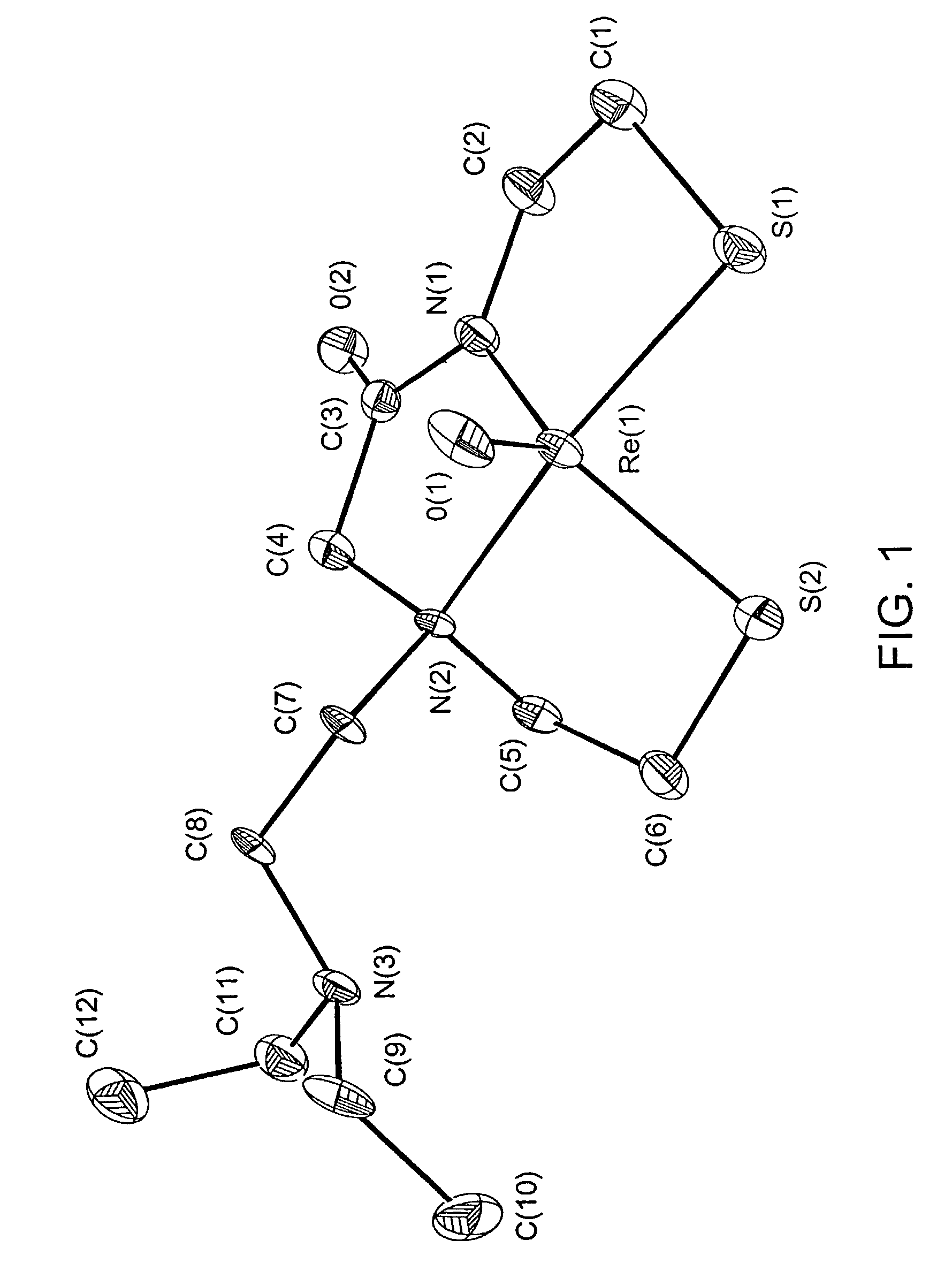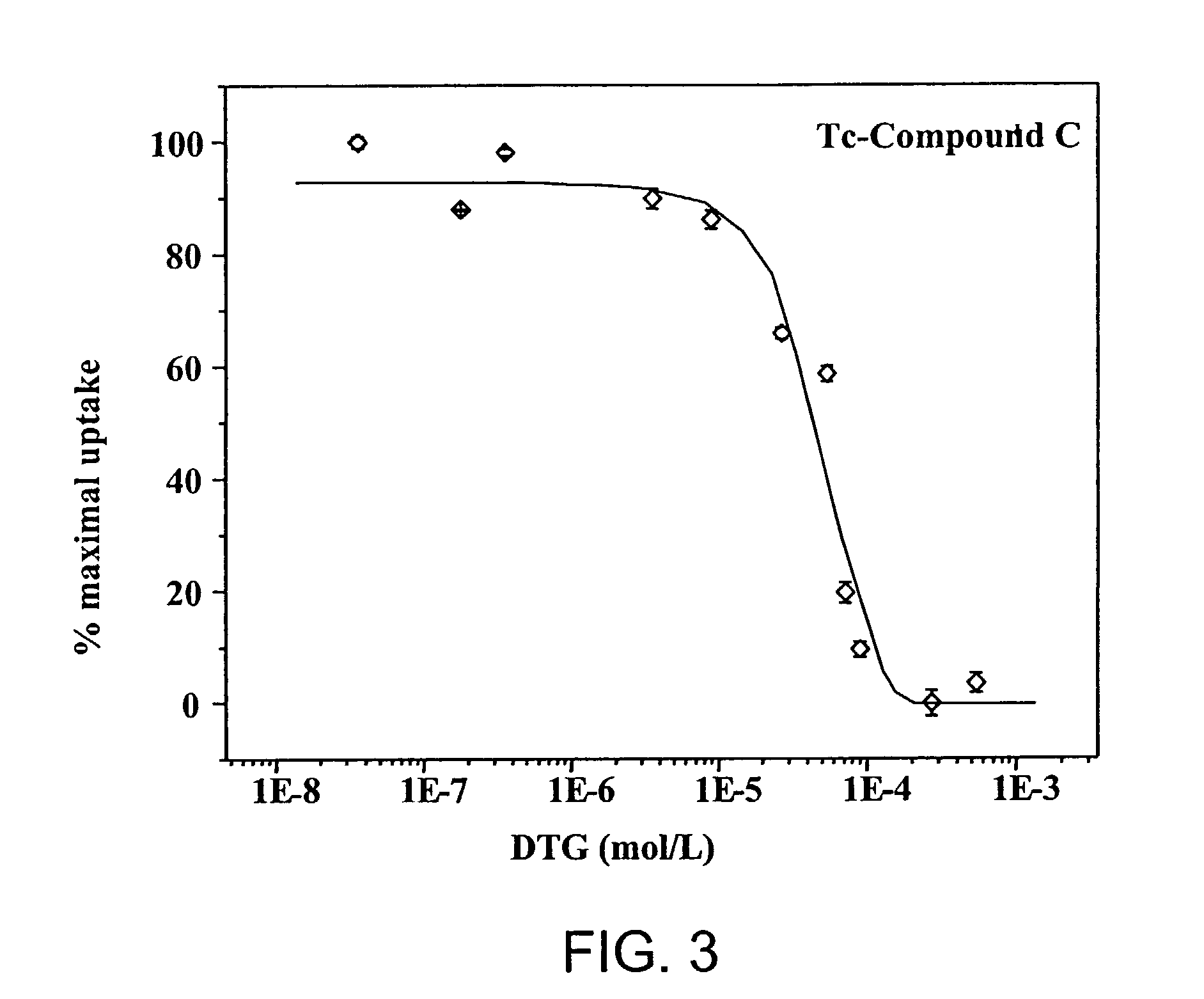Small technetium-99m and rhenium labeled agents and methods for imaging tumors
a technology of radiometal and tumor imaging, applied in the direction of group 3/13 element organic compounds, drug compositions, peptides, etc., can solve the problems of low tumor to non-tumor ratio, and significant mortality of this diseas
- Summary
- Abstract
- Description
- Claims
- Application Information
AI Technical Summary
Benefits of technology
Problems solved by technology
Method used
Image
Examples
example 1
N-[(2-diethylaminoethyl)-N-(2-(2-(S-(triphenyl-methyl)thio)ethyl)amino)acetyl]-S-(triphenylmethyl)-2-aminoethane-thiol, [AADT-(Trt)2-N—CH2CH2—N(CH2CH3)2] (Compound A)
[0256]N-(2-diethylamino)ethyl chloride (68.8 mg, 0.4 mmol), AADT-(Trt)2 (252 mg, 0.4 mmol), KI (199.2 mg, 1.2 mmol) and K2CO3 (276.4 mg, 2 mmol) were added to 50 mL CH3CN, and the solution was refluxed under argon atmosphere for 24 h. After cooling to room temperature, the inorganic salts were filtered, and the filtrate was evaporated to dryness. The residue was redissolved in CH2Cl2 and extracted with a basic (pH 11) aqueous solution. The CH2Cl2 portion was evaporated to a minimum volume and chromatographed on a silica-gel column with the following sequence of eluents: 100 mL CH2Cl2, 200 mL 1% MeOH / CH2Cl2, and 200 mL 2% MeOH / CH2Cl2. TLC (SiO2): 7% NH3 / MeOH (5% NH4OH in MeOH) / 93% CH2Cl2. The product was isolated as a yellow viscous oil (42% yield). 1H NMR (CDCl3) δ 7.946 (t, 1H, NH), 7.435-7.208 (m, 30H, Ar), 3.116-3.07...
example 2
N-[(2-dibutylaminoethyl)-N-(2-(2-(S-(triphenylmethyl)thio)ethyl)amino)-acetyl]-S-(triphenylmethyl)-2-aminoethanethiol, [AADT-N—CH2CH2—N(C4H9)2] (Compound B)
[0257]This compound was prepared analogous to the procedure previously described in EXAMPLE 1, except that N-(2-dibutylamino)ethyl chloride (0.401 mmol) was substituted for the N-(2-diethylamino)ethyl chloride. Purification was carried out on a silica-gel TLC-plate that was developed in 7% methanolic NH3 (5% NH4OH in MeOH) / 93% CH2Cl2. The product was obtained as a yellowish viscous oil (38% yield). 1H NMR (CDCl3) δ 7.829-7.745 (s, 1H, NH), 7.440-7.350 (m, 12H, Ar), 7.295-7.242 (m, 12H, Ar), 7.230-7.100 (m, 6H, Ar), 3.090-3.035 (q, 2H, —CH2), 2.929 (s, 2H, —CH2CO), 2.540-2.300 (m, 12H, —CH2—), 2.297-2.265 (m, 2H, —CH2—), 1.360 (brs, 4H, —CH2—), 1.285-1.220 (m, 4H, —CH2—), 0.894 (t, 6H, —CH3); Mass Spec (MW=833.2) observed 834 (M+H)+. Anal (C54H63N3OS2) calcd (found): C, 77.75 (77.03); H, 7.61 (7.62); N, 5.04 (5.03).
example 3
N-[(3-diethylaminopropyl)-N-(2-(2-(S-(triphenylmethyl)thio)ethyl)amino)-acetyl]-S-(triphenylmethyl)-2-aminoethanethiol, [AADT-N—CH2CH2CH2—N(CH2—CH3)2] (Compound C)
[0258]AADT-N—CH2CH2—CH2—Cl, Compound E, which is prepared according to the method described in Mahmood, A.; Kucluma, M. H.; Freiberg, E.; Goldstone, J.; Davison, A.; Jones, A. G. Functionalized Tetradentate Chelates and Their Technetium-99 and Rhenium Complexes: Synthesis, Spectroscopy and Structural Characterization. In Technetium, Rhenium and Other Metals in Chemistry and Nuclear Medicine 5; Nicolini, M., Mazzi, U., Eds.; Servizi Grafici Editoriali: Padova, 1999; pp 253-257, (310 mg, 0.4 mmol), diethyl amine (59.9 mg, 0.4 mmol), KI (340.1 mg, 2.1 mmol), and K2CO3 (141.7 mg, 1.0 mmol) were added to 50 mL CH3CN, and the solution was refluxed for 24 h. The product was purified via silica-gel chromatography with 3% methanolic NH3 (5% NH4OH in MeOH) / 97% CH2Cl2, yielding a yellowish oil (72% yield). 1H NMR (CDCl3) δ 7.535-7.50...
PUM
| Property | Measurement | Unit |
|---|---|---|
| flow rate | aaaaa | aaaaa |
| pH | aaaaa | aaaaa |
| pKa | aaaaa | aaaaa |
Abstract
Description
Claims
Application Information
 Login to View More
Login to View More - R&D
- Intellectual Property
- Life Sciences
- Materials
- Tech Scout
- Unparalleled Data Quality
- Higher Quality Content
- 60% Fewer Hallucinations
Browse by: Latest US Patents, China's latest patents, Technical Efficacy Thesaurus, Application Domain, Technology Topic, Popular Technical Reports.
© 2025 PatSnap. All rights reserved.Legal|Privacy policy|Modern Slavery Act Transparency Statement|Sitemap|About US| Contact US: help@patsnap.com



